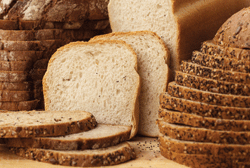New key to fresh bread; Population shifts affect food choices; How foods affect eating behavior
NEWS
 New key to fresh bread
New key to fresh bread
A compound in bread linked to antifungal properties may one day complement or replace artificial preservatives used to increase the shelf life of bread, according to a study published in Applied and Environmental Microbiology.
Researchers with the University of Alberta analyzed strains of mold fermented in sourdough bread and were able to isolate hydroxy fatty acids, compounds that can help keep bread fresh without altering its flavor. Preservatives that are used in commercially produced bread help to extend shelf life but also alter the flavor and odor of the bread, said Michael Ganzle, professor and Canada Research Chair of the University of Alberta’s Dept. of Agricultural, Food, and Nutritional Science. The researchers were able to achieve a shelf life of more than 6 days with the hydroxy fatty acid monohydroxy octadecenoic acid, which was produced when Lactobacillus hammesii converted linoleic acid in sourdough.
The study, “Antifungal Hydroxy Fatty Acids Produced during Sourdough Fermentation: Microbial and Enzymatic Pathways, and Antifungal Activity in Bread,” was published in the March 6, 2013, issue of Applied and Environmental Microbiology.
Population shifts affect food choices
The growth of Hispanic and Asian communities—a combined 22% of the U.S. population—is affecting culinary and food product development in new ways, according to CCD Innovation. Add to this the number of Americans who are interested in and embrace multicultural influences and the result is a population that demands authentic and novel global foods.
“It’s clear from population statistics, and from the regional cuisine trends we’ve been tracking for years now, that we live in a multicultural America that requires a wide bandwidth of multicultural food offerings,” said Kimberly Egan, CEO of CCD Innovation.
The food can be traditional using authentic ingredients and longstanding cooking and processing methods or it can be mixed and matched with other cuisines. CCD Innovation cited some examples of the latter such as lomo saltado, a sliced beef dish that blends cultural influences of China and Peru, Asian burritos, Vietnamese coffee, frozen treats that feature new fruits and spices, one-bowl meals with a foundation of rice or noodles, grilled foods featuring Asian and Hispanic flavoring marinades and spice rubs, and convenience meals that go beyond typical Asian and Hispanic flavors, seasonings, and products.
 How foods affect eating behavior
How foods affect eating behavior
Two studies published in Appetite show how different foods affect eating behavior and calorie intake.
The first study examined how sensory properties of hot foods and meals influence eating behavior and food intake. The study subjects ate a standard 50 g of each of the 35 food items, seven of which were tested over five consecutive days while the researchers video recorded them to calculate the eating rate, chew rate, average bite size, average chews per bite, and overall oral duration time for each of the foods. The results showed that softer foods such as mashed carrots, lasagna, and canned tomatoes were eaten in larger bite sizes with fewer chews per bite, resulting in a much faster eating rate (g/min). Foods consumed in smaller bite sizes, which were chewed longer, resulted in slower eating rates and more fullness in the subjects, said the researchers.
For the second study, the researchers tested whether foods that require more chewing and that stay in the mouth longer promote feelings of fullness and therefore reduce energy intake. The test meals were steak and gravy, carrots, and potatoes in whole and mashed textures with gravy of high and low flavor intensity. They served the meals to four groups of subjects. They measured the food intake and compared it across each group and meal condition, and they recorded the duration of each subject’s mealtime to compare eating rates. The subjects who ate the whole vegetables and steak consumed about 10% less than those who ate the mashed vegetables and steak. The subjects consumed the mashed meal 20% faster than the whole meal, which was the equivalent of an extra 10 g per minute of food eaten.
“With the knowledge gained from these studies, we can make more pleasurable and satisfying meals that promote fullness with fewer calories,” said Ciarán Forde, Nestlé scientist and research leader.
The studies, which appear in the Jan. 1, 2013, issue of Appetite, were conducted by Nestlé Research Center, Lausanne, Switzerland, and Wageningen University, Wageningen, the Netherlands.
--- PAGE BREAK ---
Nominees sought for World Food Prize
Nominations are being accepted for the 2013 World Food Prize, which recognizes individuals who have advanced human development by improving the quality, quantity, or availability of food around the world. The World Food Prize is a $250,000 award presented at the Laureate Award Ceremony in mid-October in Des Moines, Iowa, in conjunction with the Borlaug Dialogue international symposium. The deadline is May 1, 2013. For more information, visit www.worldfoodprize.org.
Tasting profile’s effects on health
A person’s tasting profile may affect the incidence of metabolic syndrome and dietary intake, and testing for these tasting profiles may help tailor dietary recommendations to minimize metabolic syndrome risk, according to a study published in Journal of Food Science.
The researchers examined the interaction of the tasting profiles sweet liker and supertaster with incidence of metabolic syndrome and found that subjects who were only a sweet liker or a supertaster had a decreased risk of having metabolic syndrome compared to those who have a combination or have neither tasting profiles.
The study, “Taking the Bitter with the Sweet: Relationship of Supertasting and Sweet Preference with Metabolic Syndrome and Dietary Intake,” appeared in the February 2013 issue of Journal of Food Science.
USDA extends comment period
The U.S. Food and Drug Administration has extended the comment period for two proposed rules required by the Food Safety Modernization Act to May 16, 2013.
The proposed rules, “Current Good Manufacturing Practice and Hazard Analysis and Riskbased Preventive Controls for Human Food” and “Standards for the Growing, Harvesting, Packing, and Holding of Produce for Human Consumption” appeared in the Jan. 16, 2013, Federal Register.
For more information, visit www.fda.gov/Food/FoodSafety/FSMA/ucm334115.htm?source=govdelivery and www.fda.gov/Food/FoodSafety/FSMA/ucm334114.htm?source=govdelivery.
Databases address food adulteration
The University of Minnesota’s National Center for Food Protection and Defense has launched two databases to help reduce economically motivated adulteration of food.
Economically motivated adulteration (EMA) is the intentional addition of foreign substances or substances of a lesser quality to food for economic gain, or the intentional mislabeling of food products. The university reports that the practice costs the food industry $10–15 billion per year.
One database will cover EMA incidents and the other EMA susceptibility. Food regulators and others who work in the food industry can access the databases at www.foodshield.org.
What’s new with food companies
• AIDP has been granted U.S. patents for Magtein’s magnesium compositions and its use for magnesium-containing food compositions.
• Barry Callebaut has acquired ASM Foods AB and the cocoa ingredients division of Petra Foods Ltd.
• Bell Flavors & Fragrances has received Safe Quality Food 2000 Level 3 for its manufacturing facility and corporate headquarters in Northbrook, Ill.
• Blue Marble Biomaterials and Sigma-Aldrich® Corp. have formed a distribution agreement.
• EnWave has signed a collaboration agreement with Gay Lea Foods Cooperative Ltd. EnWave has also signed a collaboration agreement with Milne Fruit Products.
• The Food and Environment Research Agency and Waters have opened an international food safety training lab in York, UK.
• Kemin has received a letter of non-objection from Health Canada allowing the use of FloraGLO® lutein in food in Canada. The company also received Global Food Safety Initiative certification for its Des Moines, Iowa, manufacturing facility.
• The National Honey Board has launched a new website, www.BeveragesWithHoney.com, to promote honey’s usage in beverages.
• Neogen Corp.’s ANSR ™ for Salmonella assay has received a matrix extension from AOAC Research Institute, and its NeoSEEK ™ STEC test is now ISO 17025 accredited through the American Association of Laboratory Accreditation.
• PerkinElmer has partnered with the Muslim clerical and halal accreditation group in Indonesia to supply its porcine detection kits for halal food compliance testing and screening.
• Symrise and Probi have formed a joint research and development agreement.
• Tate & Lyle has launched an open innovation portal at www.tateandlyleopeninnovation.com.
 Karen Nachay
Karen Nachay
Associate Editor
[email protected]
